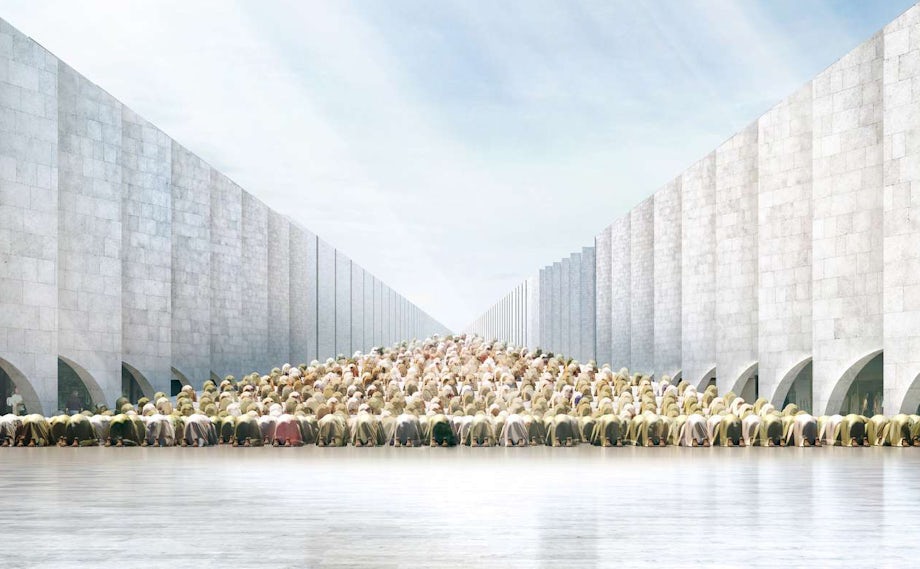Architects: Want to have your project featured? Showcase your work by uploading projects to Architizer and sign up for our inspirational newsletters.
Designing a mosque entails very specific challenges for architects: the strict and detailed requirements for the typology were established centuries ago and remain paramount in creating a place of worship for Muslims. Consequently, these buildings have long been associated with conservative styles employing well-recognized traditional forms and aesthetic details.
Even so, Henning Larsen Architects has set out to prove that it is possible to design a modern mosque that speaks to the younger Islamic generation while respecting those age-old traditions. Back in 2015, they unveiled plans for a contemporary mosque in Copenhagen, displaying a sculptural cluster of domes in a felicitous mix of Nordic and Islamic styles.


The volumes are drawn together to form a large central space under an undulating ceiling, with a circular pool in the central court acting as a reflective focal point. The walls and ceiling are pierced by a constellation of windows and skylights that throw light across the interior in a manner similar to Jean Nouvel’s perforated Louvre in Abu Dhabi.
The domed forms and minimalist detailing form an abstract interpretation of traditional Arabic architecture, a daring move that has been harnessed by a number of firms venturing into the realms of Islamic design in recent times. Here are seven more projects that bring modernism (and occasionally postmodernism) to mosques — each with their own contemporary twist…



Islamic Cultural Center and Museum of Tolerance by BIG – Bjarke Ingels Group, Tirana, Albania
BIG Architects won a competition to design a mosque, Islamic center and museum in Tirana, Albania. Their proposal is a formal inversion of the traditional domed mosque volume, with three buildings clustered around a public plaza that is intended as a spatial and programmatic extension of the internal spaces.



Masjid Permata Qolbu by MASS, Jakarta, Indonesia
Constructed in 2013 in the Indonesian capital, this mosque is defined by distinctive white ribs that possess rhythmic qualities similar to buttresses seen in Christian ecclesiastic buildings. The building’s architectural language is carried across to the mosque’s very modern minaret, comprising two intersecting fins and a loudspeaker that announces prayer time.



The Vanishing Mosque by Rux Design, U.A.E.
Rux Design asked themselves: “What if a mosque was not a building? What if it vanished into the fabric of a city?” Their answer was the Vanishing Mosque, a minimalist open-air place of worship in an angular urban courtyard in the U.A.E. The ground plane appears to have been lifted up by a single corner, forming a diminishing terrace of stone prayer steps oriented toward Mecca.



Halide Edip Adivar Mosque by Manco Architects, Istanbul, Turkey
Manco Architects’ concept attempts to fuse the introverted privacy of the traditional “Kulliye” (a complex of mosque and supplementary buildings with various functions) with the open public spaces now popular in contemporary civic design. The focal point is a simple, pixelated concrete box, employing a subtle use of light that transforms the mosque into an urban lantern by night.



King Abdullah Financial District Mosque by FXFOWLE Architects
Designed in collaboration with Buro Happold Consultants, this mosque is designed as part of a huge development in the fast-growing city of Riyadh, Saudi Arabia. The proposal utilizes the traditional materials of black and white marble in a contemporary way, forming a faceted box covered with aluminum screens, each of which is laser-cut with abstract interpretations of the eight-pointed Islamic star.



Camlica Mosque by Tuncer Cakmakli Architects, Istanbul, Turkey
This competition entry for a site on Istanbul’s prominent Camlica Hill aims to put nature at the heart of the mosque. A towering green wall of roses, jasmines, and other flowers wraps around a huge central plaza intended to evoke the sensation of gathering with a Garden of Eden. The concept will remain just that, however, as the winning design for a highly traditional mosque by Bahar Mizrak and Hayriye Gül Totu is now under construction.



Wall Dome by Paolo Venturella Architects
Perhaps the most unorthodox design in our collection, Venturella’s competition proposal for Prishtina in Kosovo is envisaged as a monolithic marriage of the two primary elements of mosque architecture, the “Kiblah Wall” and the “Dome.” The modern abstraction of these elements is complemented by the modern treatment of its external surface, which incorporates photovoltaic louvers to help power the complex.
Architects: Want to have your project featured? Showcase your work by uploading projects to Architizer and sign up for our inspirational newsletters.

 CAMLICA MOSQUE
CAMLICA MOSQUE  Halide Edip Adivar Mosque
Halide Edip Adivar Mosque  Islamic Community Centre and Mosque
Islamic Community Centre and Mosque  ISLAMIC CULTURAL CENTER and MUSEUM OF TOLERANCE
ISLAMIC CULTURAL CENTER and MUSEUM OF TOLERANCE  King Abdullah Financial District Mosque
King Abdullah Financial District Mosque  Masjid Permata Qolbu
Masjid Permata Qolbu  The Vanishing Mosque
The Vanishing Mosque  WALL DOME
WALL DOME 

